Origin of radioactivity
Radioactivity refers to the property of certain atomic nuclei to emit energy in the form of ionising radiation. A radionuclide is an atom with an unstable nucleus. Ionising radiation is very high-energy radiation. When ionising radiation hits atoms, electrically charged particles - so-called ions - can be produced.
Most of the radioactivity measured in Austria comes from natural sources and can be detected everywhere in the environment. Natural radionuclides can be categorised into two groups according to their origin: primordial or cosmogenic. Primordial radionuclides have been present since the formation of our solar system. Cosmogenic radionuclides are produced continuously through the interaction of very high-energy cosmic radiation with the Earth's atmosphere.
Radioactive substances that do not occur naturally but are produced by humans are called artificial radionuclides. The majority of the use of artificial radionuclides and ionising radiation is in the medical field.
Laboratory-based environmental monitoring
As part of laboratory-based environmental monitoring, we regularly determine the radioactivity content of various environmental media. To this end, we carry out more than 2,500 laboratory analyses every year on behalf of the BMLUK. The following media are analysed: Air, precipitation, surface water, sewage sludge, wastewater from sewage treatment plants, soil, vegetation, animal feed and fertilisers. The following diagram shows the specified sampling locations throughout Austria.

Continuous monitoring enables us to detect even slight increases in radioactivity in the environment and report these immediately to the responsible federal ministry. In the event of conspicuous measured values, an exchange takes place at European and international level via the EU and the IAEA (International Atomic Energy Agency). At the same time, the public is informed.
In addition, radioactivity laboratories around the world are in direct contact with each other and exchange information.

Radionuclides can be transported and distributed over a wide area via the atmosphere. Therefore, measuring radioactivity in the air is one of the most important tasks that we carry out as part of environmental monitoring. Radioactive particles in the air are collected throughout Austria at eleven locations in Retz, Alt-Prerau, Vienna, Linz, Graz, Straß, Klagenfurt, Salzburg, Sonnblick, Innsbruck and Bregenz (see graphic).
Most radioactive substances in the air are bound to droplets or particles (aerosols). Sampling is mainly carried out with aerosol samplers. Air is sucked through a filter in which droplets and particles remain suspended and are thus collected. At some locations (Vienna, Linz and Innsbruck), special collection devices are also used to detect gaseous radionuclides such as radioactive iodine.
Samples are taken over a period of one week. The samples are then analysed by gamma spectrometry in our radioactivity measurement laboratories, and our experts immediately report any unusual readings to the relevant federal ministries.
In 2024, a total of 752 samples were collected and analysed for air monitoring.
It is mainly natural radionuclides that are detected in the air. These originate from the radioactive noble gas radon or are produced in the atmosphere by radiation from outer space (cosmogenic radionuclides).
Radionuclides - Klagenfurt: Beryllium-7
The most important cosmogenic radionuclide is beryllium-7. The following graph shows an example of the course of the beryllium-7 activity concentration in the air in Klagenfurt over the last few years. The fluctuations at different times of the year are primarily dependent on meteorological factors.

Radionuclides - Klagenfurt: Caesium-137
In addition to the natural radionuclides, the artificial radionuclide caesium-137 is also regularly detected in the air, most of which originates from the Chernobyl reactor accident. The following graph shows an example of the cesium-137 activity concentration in the air in Klagenfurt. In addition to a steady decrease, the curve also shows seasonal fluctuations. The higher values in the winter months are caused by meteorological factors, such as a lower exchange between the air layers.

Radionuclides - Klagenfurt: comparison of beryllium-7 and caesium-137
A comparison of the measured values of the two radionuclides clearly shows that the activity concentrations of the artificial radionuclide caesium-137 are hundreds to tens of thousands of times lower than the activity concentrations of the natural radionuclide beryllium-7, depending on the time of year (see graph below).

In addition to the radionuclides that regularly occur in the air, small amounts of iodine-131 were detected six times in air filters from Klagenfurt in 2024. The measurement results were only just above the detection limit with values between 0.4 and 1.2 μBq/m³.
The measurement results are not relevant from a health perspective.

Air currents can transport radioactive particles over long distances. Precipitation, such as rain or snow, washes these particles out of the atmosphere and deposits them on the ground. Precipitation is therefore considered a meaningful indicator of the spread of radioactivity in the environment. The measurement of radioactivity in precipitation is therefore an important task that we carry out as part of environmental monitoring. Precipitation samples are collected at nine locations throughout Austria (see diagram).
The precipitation samples are collected at each location over a period of one month and then analysed by gamma spectrometry in our radioactivity measurement laboratories. The tritium content in all samples is also determined using liquid scintillation spectrometry.
Any unusual measured values are immediately reported to the responsible federal ministries.
In 2024, a total of 108 samples were collected and analysed for precipitation monitoring.
The radionuclides tritium, beryllium-7 and caesium-137 are typically detected in the precipitation. The graph shows the course of the tritium activity concentration in precipitation.
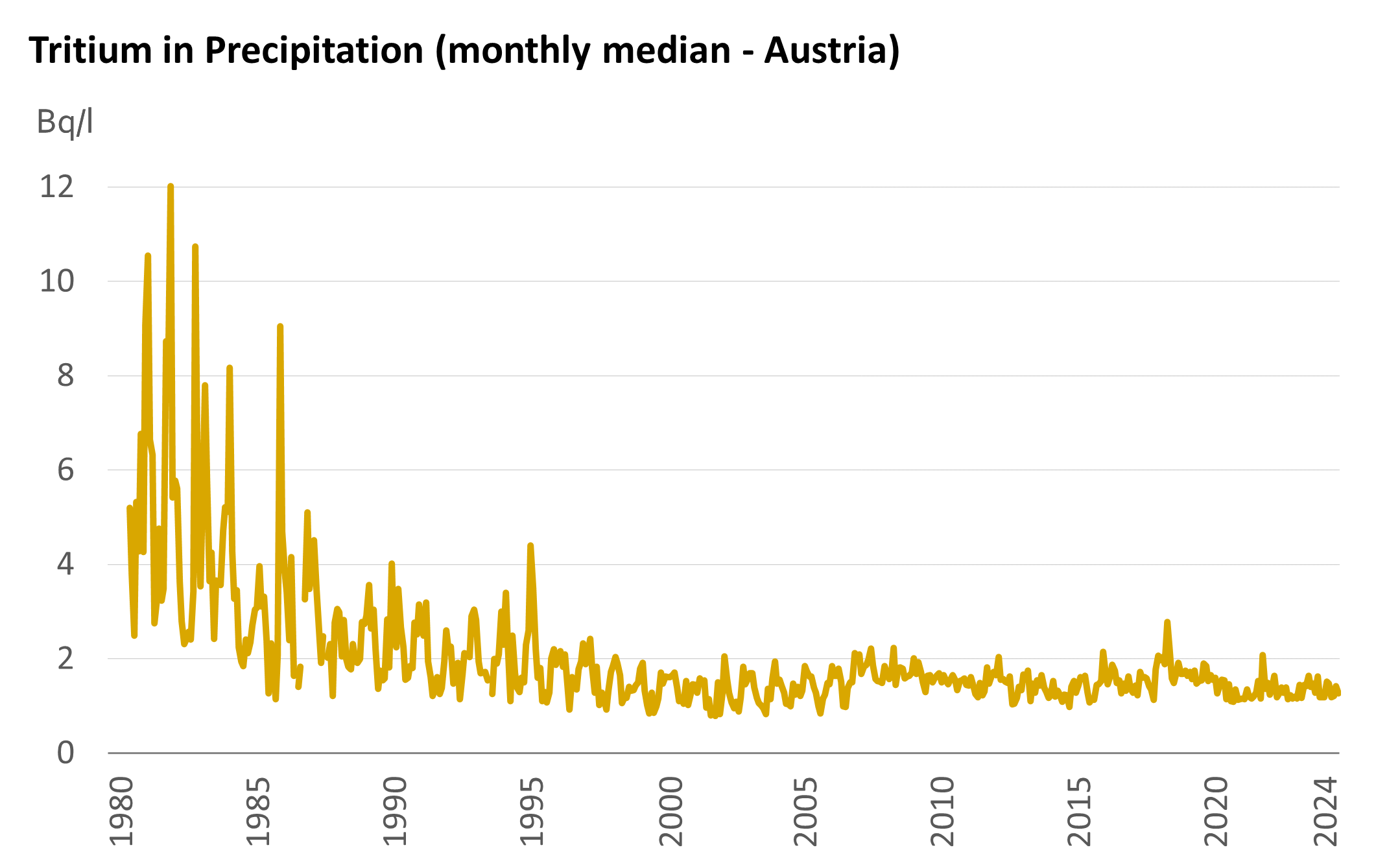
The tritium present in the environment today is partly of cosmogenic and partly of artificial origin. "Cosmogenic" means that the tritium is produced in the Earth's atmosphere by particle radiation from space. The atmospheric nuclear weapons tests of the 1950s and 1960s are the main source of the artificial tritium content.
The caesium-137 regularly detected in precipitation largely originates from the Chernobyl reactor accident. In 2024, 14 measured values were above the detection limit. The highest measured value was 0.05 Bq/m² (Linz, September 2024), the median was 0.03 Bq/m². The measured values were thus within the range of recent years.
No health-relevant values were detected.

Of the surface waters, it is primarily the larger transboundary bodies of water that are monitored in order to be able to record possible discharges. In order to ensure that no radionuclides are discharged into the water in Austria, samples are also taken from the outflow from Austria on the major rivers.
The samples are generally taken monthly as random samples. In addition, some rivers are sampled using automatic collection devices. These are used to take samples at regular intervals over the course of a month, which are then combined to form a total sample. This comes very close to continuous sampling.
Surface water is sampled at 19 locations in all federal states across Austria (see chart). In 2024, a total of 286 surface water samples were collected and analysed.
The radionuclides tritium, beryllium-7, potassium-40 and caesium-137 are typically detected in surface water. The natural radionuclide beryllium-7 and the natural portion of tritium are continuously produced in the atmosphere (cosmogenic). Potassium-40 is a natural radionuclide with a very long half-life that already existed when the solar system was formed (primordial radionuclide).
The graph shows the course of the tritium activity concentration at two sampling points on the Thaya. An annual average value was calculated from the monthly measured values.
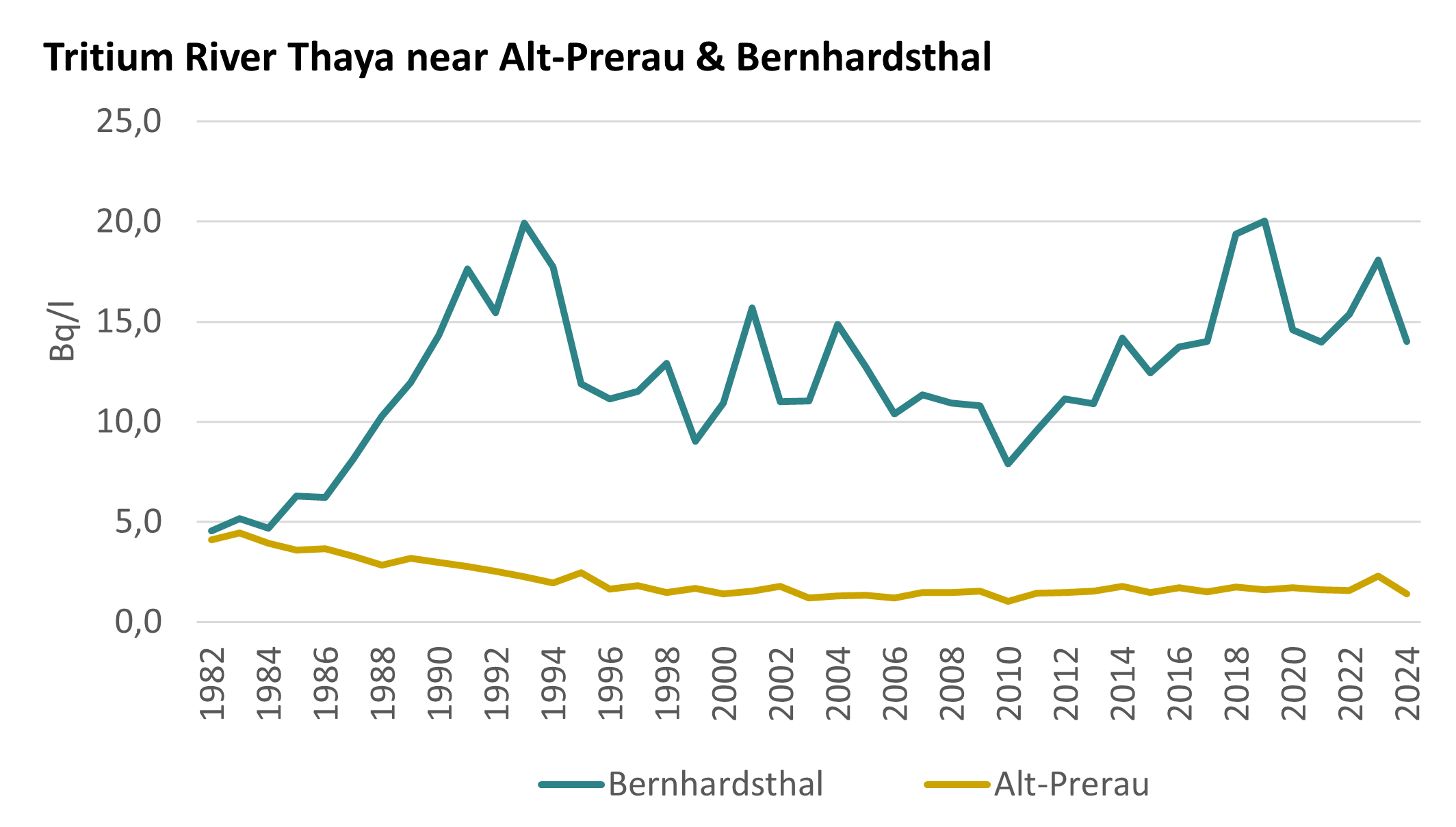
Elevated tritium activity concentrations have been detected at the sampling site on the Thaya in Bernhardsthal since around mid-1985. No elevated tritium values have been recorded at the upstream sampling point in Alt-Prerau. After Alt-Prerau, the Thaya leaves Austria and flows through Czech territory as far as Bernhardsthal. There it is fed by the Jihlava River, on the upper reaches of which the Dukovany nuclear power plant is located. The origin of the tritium is therefore assumed to be in the Czech Republic.
Increased tritium activity concentrations have also been found in the Morava River, into which the Dyje flows, since 1985. Due to the increasing dilution with water from tributaries, the tritium levels decrease downstream.
The activity concentrations of the radionuclides regularly found in surface waters in 2024 corresponded to the long-term average.
No values relevant to health were detected.
The Chernobyl reactor accident in 1986 led to the widespread dispersal of various radionuclides in Europe by air currents. In some places, the radionuclides in the air were washed out onto the ground by precipitation. The respective precipitation situation during the passage of the radioactively contaminated air masses was therefore primarily decisive for the extent of regional soil contamination. Of the radionuclides deposited at that time, only caesium-137 is still of some significance today.
Austrian caesium map
In 1994 and 1995, the then Federal Ministry of Health and Consumer Protection, together with the Federal Environment Agency, collected all available data on the deposition of caesium-137 in Austria. The data was summarised in the form of a "caesium map" of Austria (see secure .umweltbundesamt.at/caesium/).
Due to the meteorological conditions at the time, Austria was one of the countries most severely affected by the Chernobyl accident. The average surface deposition of caesium-137 was determined to be 21 kBq/m². The peak values were just over 150 kBq/m². Since then, these values have been decreasing continuously in line with the radioactive decay of caesium-137. During the reporting period, they were around half of the original values.
Many of Austria's neighbouring countries operate nuclear power plants. Regular measurements are carried out to detect any emissions from neighbouring plants.
As early as 1992, the investigation programme "Evidence Preservation Temelín Nuclear Power Plant" was launched in cooperation with the province of Upper Austria in order to reliably detect any radioactive emissions caused by the operation of the Temelin NPP in Upper Austria. The original sampling points were mainly located in the border area with the Czech Republic, but were expanded in 2016 to include additional sampling points in other federal states (see figure).
The environmental media precipitation, soil, vegetation and spruce needles as well as cereals are sampled at regular intervals as part of the investigation programme and analysed in our measurement laboratory. Gamma spectrometry is used to determine the caesium-137 activity concentrations in the environmental samples. Furthermore, tritium and total alpha+beta concentrations (strontium-90) are determined using liquid scintillation spectrometry (LSC).
In addition, on-site measurements are carried out annually using mobile gamma spectrometers at all vegetation and soil sampling points (in-situ measurements). Depth profiles are also taken at regular intervals in order to observe the long-term behaviour of various radionuclides in the soil - in particular caesium-137 from the Chernobyl reactor accident.
The project has already created a good radioecological database for documenting the current status in order to be able to react quickly to any changes in the radionuclide concentrations of selected environmental media. At the same time, the project represents good preparation for a radiological emergency, as sampling and measurements are practised regularly.
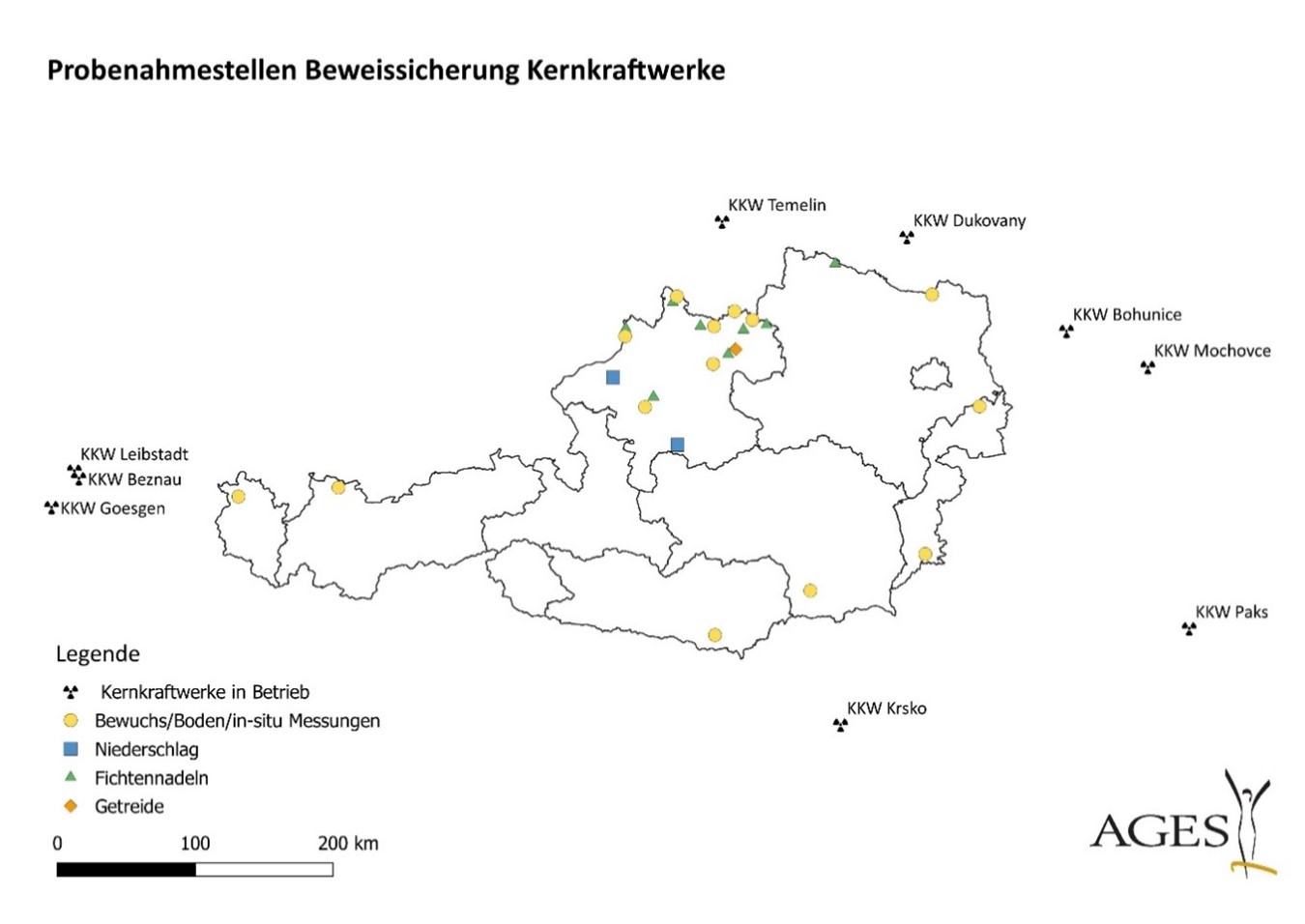
In 2024, no new discharges from the operation of nuclear power plants were detected. In addition to natural radionuclides, the main radionuclide of human origin detected was caesium-137 from the Chernobyl reactor accident.
The activities detected in the samples in 2024 are not relevant to health.

The wastewater and sewage sludge from the wastewater treatment plants in Gössendorf (Graz), Feuerbach (Klagenfurt), Asten (Linz) and Simmering (Vienna) are regularly analysed for radioactive substances. In September 2024, the monitoring programme was expanded to include the Siggerwiesen (Salzburg) and Roßau (Innsbruck) wastewater treatment plants. This means that the radionuclides used by the nuclear medicine institutes in the catchment areas of the Inn and Salzach rivers can now also be recorded.
The samples from the wastewater treatment plants are taken monthly as random samples. In addition, samples are taken from the inlet and outlet of the Asten wastewater treatment plant (Linz) using automatic collection devices. This comes very close to continuous sampling.
In 2024, a total of 144 samples were collected and analysed to monitor wastewater treatment plants in Austria.
In addition to natural radionuclides and radionuclides from the Chernobyl accident, radionuclides used in nuclear medicine for diagnostic and therapeutic purposes are also detected in wastewater and sewage sludge samples. These radionuclides mainly enter wastewater treatment plants via patient excretions. Gallium-67, iodine-123, iodine-131, indium-111, lutetium-177, technetium-99m, samarium-153, thallium-201 and thallium-202 are regularly detected.
Lutetium-177 is used, for example, in a therapy procedure for prostate cancer. Other radionuclides are used in scintigraphy. Scintigraphy is an imaging technique in which radionuclides accumulate in certain types of tissue and can thus be visualised in images. For example, a bone tumour can be found in this way.
The radionuclides used in medicine generally have a very short half-life and therefore decay very quickly into non-radioactive elements. As a result, these radionuclides do not accumulate in the environment.
The following graph shows the annual median of the measured values above the detection limit in sewage sludge and digested sludge for the radionuclides from nuclear medicine with the highest activity concentrations (technetium-99m, lutetium-177 and iodine-131). Sewage sludge is a waste product from wastewater treatment in sewage treatment plants. Digested sludge is sewage sludge that has been stabilised by digestion.
The measured values refer to the dry mass of the samples. The annual median of the measured values for technetium-99m and iodine-131 is approximately the same over the years. For lutetium-177, a slight increase can be seen from 2022, which indicates increased use in cancer therapy.
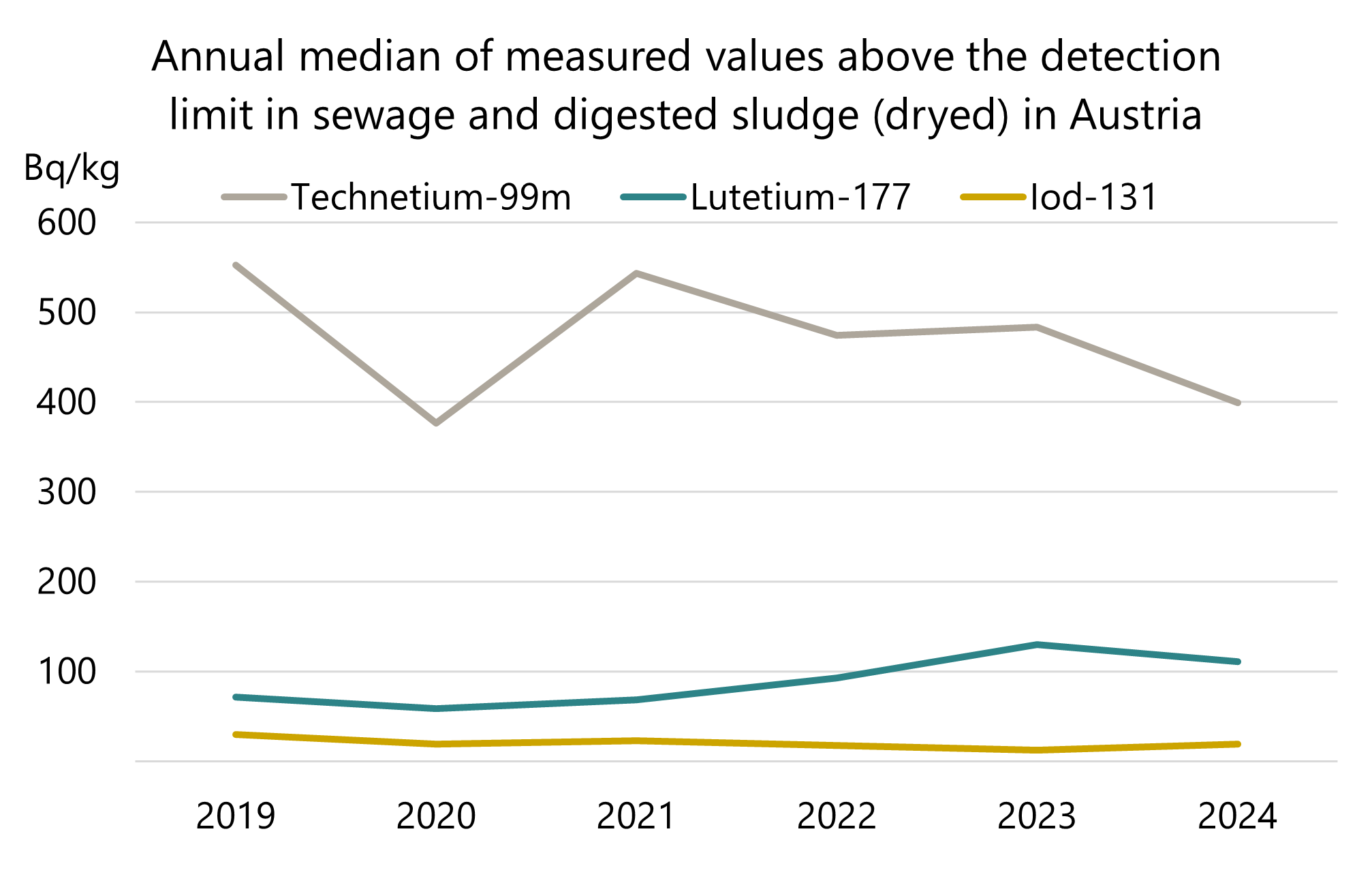
The activity concentrations of the other radionuclides used in nuclear medicine are usually in the order of 10 Bq/kg on an annual average. Gallium-67 and samarium-153 could not be measured in any samples in 2024.
The annual average activity concentrations in wastewater from sewage treatment plants reach values that are hundreds to thousands of times lower than those in sewage and digested sludge.
As in previous years, no health-relevant values were detected in the samples in 2024.
The Danube monitoring project has been monitoring Danube radioactivity in the Austrian section of the Danube for many years. Samples are continuously taken by Verbund Hydro Power GmbH at the Aschach, Wallsee, Greifenstein and Freudenau hydropower plants. The samples are then sent to "via donau" - Österreichische Wasserstraßen-Gesellschaft mbH - for analysis of various parameters. The filtered and dried water residues are then sent to our measurement laboratory for radioactivity measurement.
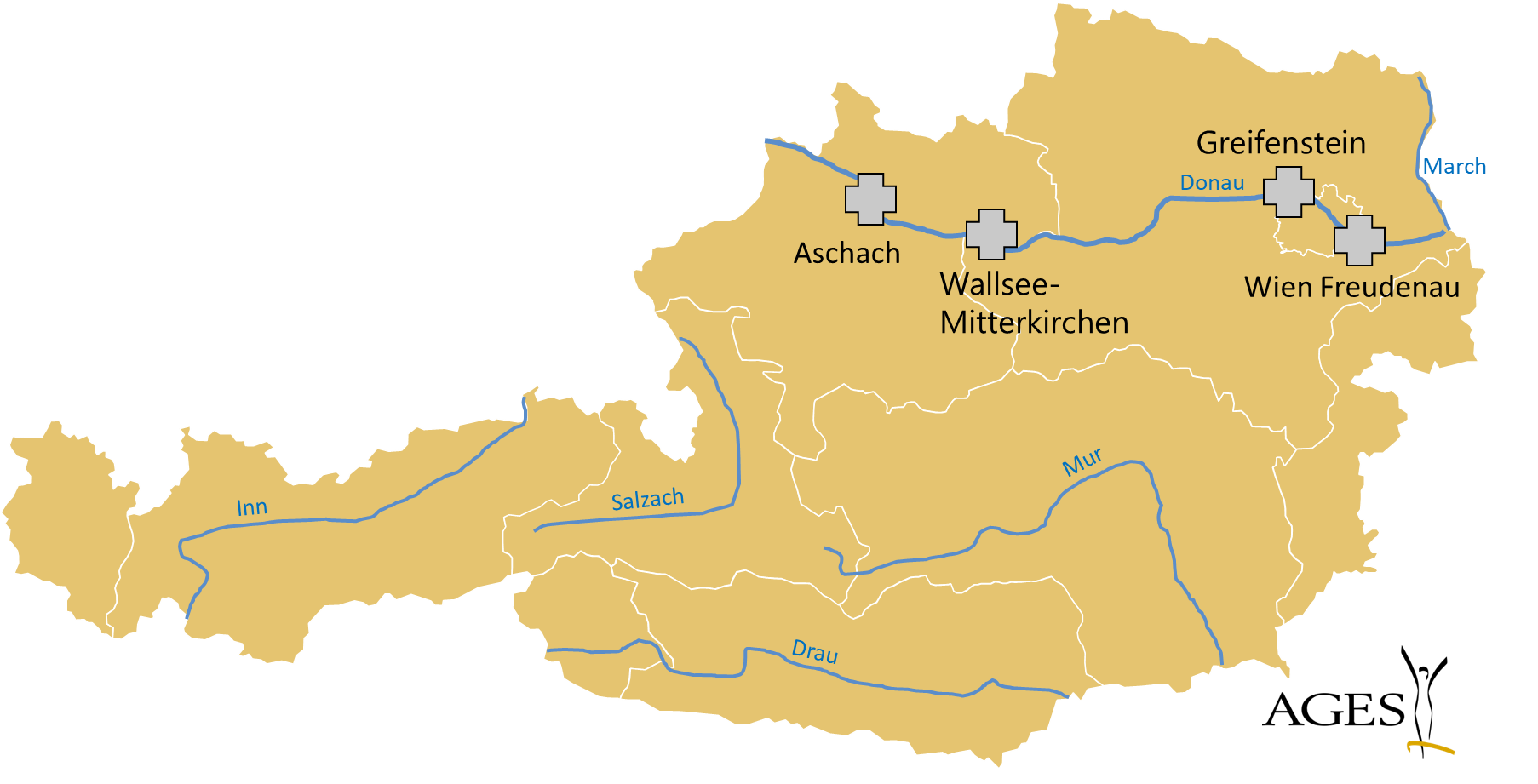
In 2024, a total of 48 Danube monitoring samples were collected and analysed for radioactivity using gamma spectrometry.
Caesium-137 was detected in 39 samples in 2024. The highest measured value was 8.9 mBq/l (Freudenau, June 2024), the median was 1.1 mBq/l.
The graph shows the development of the caesium-137 activity concentration at the Wallsee sampling site in recent years.
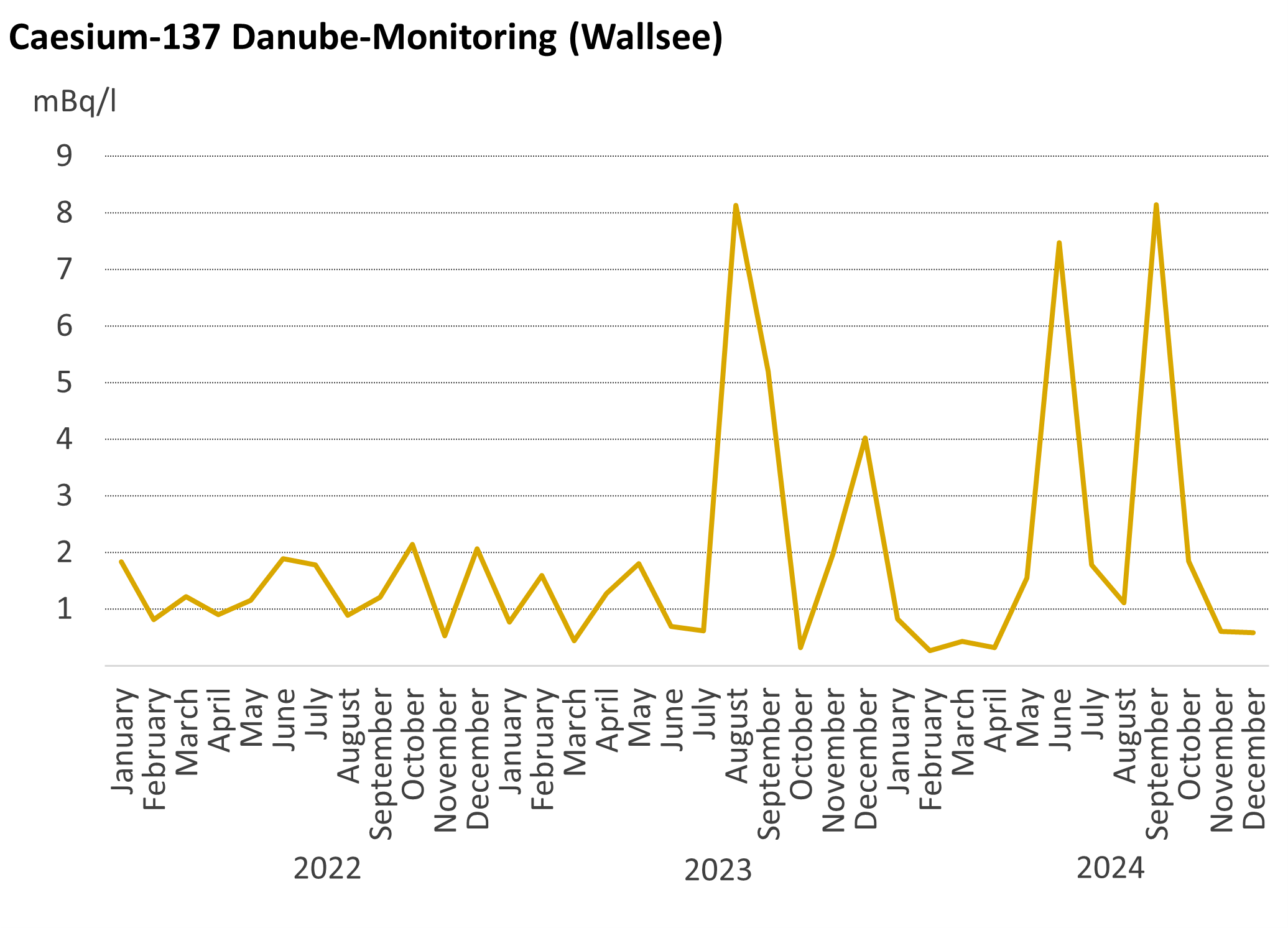
Higher caesium-137 activity concentrations are usually detected at higher flow rates of the Danube. At higher water flow rates, the Danube transports more sediment per litre, to which the caesium-137 adheres. In August and September 2023, as well as in June and September 2024, there was above-average precipitation and therefore a higher water flow in the Danube. Higher caesium-137 activity concentrations were therefore measured during this period.
In addition to the gamma spectrometric analyses, annual composite samples (Wallsee and Aschach) and two-month composite samples (Greifenstein and Freudenau) are analysed for strontium-90 and plutonium (plutonium-238, plutonium-239 and plutonium-240). The measurement is carried out after radiochemical preparation using LSC (liquid scintillation counter - liquid scintillation spectrometry) and alpha spectrometry.
In 2024, no plutonium-239 and -240 were detected in the samples. Strontium-90 was measured in small traces in one sample (0.11 mBq/l in Freudenau in March/April 2024).
The activity concentrations of the radionuclides detected were within the range of previous years and are not relevant from a health perspective.
Contact us
Mag. Dr. Claudia Landstetter
- strahlenschutz.wien@ages.at
- +43 664 8398143
-
Spargelfeldstraße 191
1220 Wien
Last updated: 16.12.2025
automatically translated